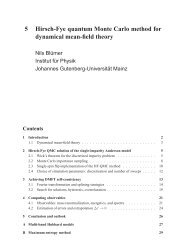Hubbard Model for Asymmetric Ultracold Fermionic ... - KOMET 337
Hubbard Model for Asymmetric Ultracold Fermionic ... - KOMET 337
Hubbard Model for Asymmetric Ultracold Fermionic ... - KOMET 337
You also want an ePaper? Increase the reach of your titles
YUMPU automatically turns print PDFs into web optimized ePapers that Google loves.
5.4. LOW TEMPERATURE LIMIT 555.4.2 Attractive U model with even number of fermionsWe will now show that at negative U our model can be mapped onto a hard-core boson model.At attractive U the ground state is the state with the maximal number of double occupancies.With an even number of fermions, that means all fermions are paired. In 0 th order the groundstate is highly degenerated, the position of the paired fermions has no influence on the energy.Again the first order contribution vanishes, since hopping of one fermion immediatelydecreases the number of doubly occupied states.In second order we again have to consider the role of H t2,1 - H t2,6 . Most of these termsvanish again:- H t2,2 = 0 because of the occurrence of (1 − ¯n i+β,−σ)d † i+β,σ- H t2,3 = 0 because of the occurrence of ¯n i+β,σd i+β,−σ- H t2,5 = 0 because of the occurrence of ¯n i+α,−σd i+α,σ- H t2,6 = 0 because of the occurrence of (1 − ¯n i+α,−σ)d † i+α,σ.These combinations of operators in these terms have an output that involves only singlyoccupied states. Again we have only two terms which are nonzero and these terms alsocontribute only <strong>for</strong> α = β. At first we will introduce bosonic creation and annihilationoperators:b † i = d† i↑ d† i↓; b i= d i↓d i↑(5.65)with the standard bosonic commutation realations:and the “hard-core” properties:[b † i ,b† j ] = 0 ; [b i ,b j ] = 0 (5.66)(b † i )2 = 0 ; (b i) 2 = 0 . (5.67)In the completely doubly occupied subspace we can identify the fermionic counting operatorswith the bosonic counting operators:With these definitions we obtain:¯n i↑≡ ¯n i↓≡ ñ i, ñ i= b † i b i. (5.68)H t2,1 = (t 2 ↑ + t2 ↓ )∑ (ij)(1 − ñ i)ñ j(5.69)∑H t2,4 = 2t ↑ t ↓ b † j b i. (5.70)We can additionally simplify H t2,1 by using:∑ñ i= Z n tot , (5.71)(ij)(ij)













